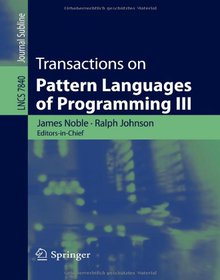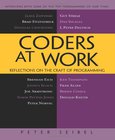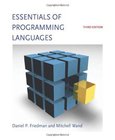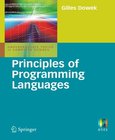Transactions on Pattern Languages of Programming III

Book Details:
| Publisher: | Springer |
| Series: | Springer |
| Author: | James Noble |
| Edition: | 1 |
| ISBN-10: | 364238675X |
| ISBN-13: | 9783642386756 |
| Pages: | 208 |
| Published: | May 15 2013 |
| Posted: | Nov 19 2014 |
| Language: | English |
| Book format: | |
| Book size: | 3.64 MB |
Book Description:
The Transactions on Pattern Languages of Programming subline aims to publish papers on patterns and pattern languages as applied to software design, development, and use, throughout all phases of the software life cycle, from requirements and design to implementation, maintenance and evolution. The primary focus of this LNCS Transactions subline is on patterns, pattern collections, and pattern languages themselves. The journal also includes reviews, survey articles, criticisms of patterns and pattern languages, as well as other research on patterns and pattern languages. This book, the third volume in the Transactions on Pattern Languages of Programming series, presents five papers that have been through a careful peer review process involving both pattern experts and domain experts. The papers present various pattern languages and a study of applying patterns and represent some of the best work that has been carried out in design patterns and pattern languages of programming over the last few years.
Download Link:
Related Books:
Coders at Work
Reflections on the Craft of Programming
Peter Seibel interviews 15 of the most interesting computer programmers alive today in Coders at Work, offering a companion volume to Apresss highly acclaimed best-seller Founders at Work by Jessica Livingston. As the words at work suggest, Peter Seibel focuses on how his interviewees tackle the day-to-day work of programming, while revealing much more, like how they became great programmers, how they recognize programming talent in others, and what kinds of problems they find most interesting. Hundreds of people have suggested names of programmers to interview on the Coders at Work web site: www.codersatwork.com. The complete list was 284 names. Having digested everyones feedback, we selected 15 folks whove been kind enough to agree to be interviewe...
Essentials of Programming Languages
3rd Edition
This book provides students with a deep, working understanding of the essential concepts of programming languages. Most of these essentials relate to the semantics, or meaning, of program elements, and the text uses interpreters (short programs that directly analyze an abstract representation of the program text) to express the semantics of many essential language elements in a way that is both clear and executable. The approach is both analytical and hands-on. The book provides views of programming languages using widely varying levels of abstraction, maintaining a clear connection between the high-level and low-level views. Exercises are a vital part...
Principles of Programming Languages
Weve known about algorithms for millennia, but weve only been writing c- puter programs for a few decades. A big di?erence between the Euclidean or Eratosthenes age and ours is that since the middle of the twentieth century, we express the algorithms we conceive using formal languages: programming languages. Computer scientists are not the only ones who use formal languages. - tometrists, for example, prescribe eyeglasses using very technical expressions, ? ? such as OD: -1.25 (-0.50) 180 OS: -1.00 (-0.25) 180 , in which the parent- ses are essential. Many such formal languages have been created throughout history: musical notation, algebraic notation, etc. In particular, such languages have long been used to control machines, such as looms and cathe...
2007 - 2021 © eBooks-IT.org



